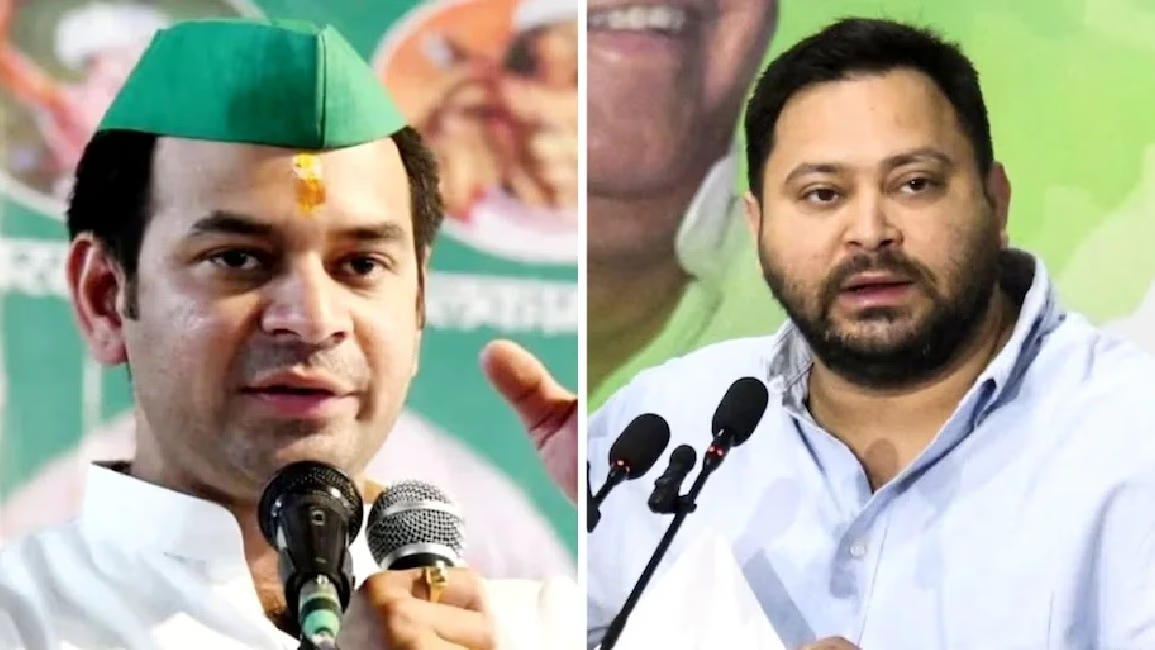In the political landscape of Bihar, the Mahua assembly constituency in Vaishali district has turned into a hot spot. Lalu Prasad Yadav's eldest son, Tej Pratap Yadav, is once again contesting from this seat, having begun his political journey here in 2015. Now, he's running under his new party, Janshakti Janata Dal (JJD). The absence of any family members during his nomination filing clearly signals that Tejashwi Yadav is determined to not let Tej Pratap reclaim this seat. However, underestimating Tej Pratap might be a political blunder, as he inherits his father Lalu Prasad's humor, making him popular in the social media era.
Gradually, with his unique charisma, Tej Pratap is winning over even his critics. Since being ousted from home, he's maintained a carefully measured demeanor. His balanced and thoughtful public statements are bound to have an impact. Although Mahua is traditionally an RJD stronghold, common people don't consider him an outsider from the Lalu family.
Should Tej Pratap leverage this sentiment, he could create significant challenges for Tejashwi. Currently, like other assembly seats in Bihar, victory here hinges on the Yadav vote bank, the role of the Dalit community, Muslim support, and development issues.
The RJD Stronghold: Mahua Seat
Created in 2008 post-delimitation, the Mahua assembly seat has deep roots in Lalu Yadav's social justice politics. RJD secured a stronghold in the 2000 and 2005 elections when Lalu's popularity peaked. In 2010, JDU's Ravindra Rai clinched victory by 21,925 votes, reflecting an NDA surge. However, in 2015, Tej Pratap Yadav recaptured the seat with a 28,155 vote majority against Hindustani Awam Morcha (Secular)'s Ravindra Rai, symbolizing the grand alliance wave and the Yadav-Muslim coalition's strength.
In 2020, Tej Pratap shifted to Hasanpur (Samastipur) and won by 21,139 votes. Back in Mahua, RJD's Mukesh Roshan defeated JDU's Ashma Parveen by 13,770 votes. The election, conducted under the shadow of COVID, saw LJP's Sanjay Kumar Singh coming third.
The current battle involves JJD's Tej Pratap, RJD's Mukesh Roshan (Tejashwi's ally), NDA's LJP (Ramvilas) candidate Sanjay Kumar Singh, and Jansuraj Party's Indrajit Pradhan. There are 286,501 voters, with 21.17% Dalits, 15.10% Muslims, and predominantly Yadavs (around 25-30%), Koeri-Kurmi (20%), and other OBCs. Young voters (18-30 years) form a majority, sensitive to development and employment issues.
Challenges Facing Tej Pratap's Campaign
1- Divided Yadav Votes and Strong NDA Lobby
The biggest threat to Tej Pratap's candidacy is the split in votes. With Mukesh Roshan enjoying Tejashwi's support, he may capture a significant chunk of Yadav votes (50-60%). In 2020, Roshan focused on local issues like roads and electricity, resonating with rural voters. Tej Pratap's expulsion from RJD exposed family rifts. Lalu family loyalists believe Tejashwi's close associate Roshan would defeat Tej Pratap on home turf, as many see Tej Pratap as an impediment to Tejashwi's chief ministerial aspirations. If Yadav votes split 50-50, Tej Pratap could see his tally drop below 50,000.
NDA candidate Sanjay Kumar Singh (LJP) is succeeding in uniting Dalit votes (21%) and the Paswan community. In the 2024 Lok Sabha, Chirag Paswan won in Hajipur (encompassing Mahua) by 170,000 votes, displaying NDA strength. The JDU-BJP organization is robust, and Modi's influence could benefit Sanjay Kumar. Jansuraj's Indrajit Pradhan is trying to cash in on youth discontent over employment and education issues.
Tej Pratap's image has its drawbacks. His controversial statements, such as 'better to die than return to RJD,' and rumors of his past marriages could alienate some voters. Tejashwi's supporters label him 'unstable,' which could sway public perception. If the turnout stays around 60% (like 2020), NDA might gain an edge.
2- Caste and Social Dynamics
If 80% of Dalits side with NDA and Yadav votes split, Tej Pratap may land in third place. Here, as across the country, caste equations hold the key to victory. Yadavs (25-30%) are Tej Pratap's core voter base but are sure to be divided with Roshan in the fray. Muslims (15%) lean towards RJD, but Tej Pratap, as 'Lalu's son,' could draw 30-40%. Dalits (21%, predominantly Paswan) are LJP's stronghold, bolstering NDA in 2010 and 2020. OBCs (Koeri-Kurmi, 20%) tend towards JDU. Women (48% of voters) will focus on development promises, where Tej Pratap's medical college is a plus point.
Reasons for Tej Pratap’s Hope:
1- Familial Heritage and Local Appeal
Tej Pratap's winning strategy banks on his 2015 success, albeit in a more complex scenario. His biggest asset is Lalu family's legacy. In Mahua, Lalu's name still unites Yadavs (25-30% of votes). Back in 2015, Tej Pratap captured more than 80% of this voter base. Recent surveys and social media trends (like #TejPratapYadav) suggest Lalu supporters view him as the 'prodigal son,' sparking emotional appeal. One user commented that while Tej Pratap might be outside RJD, he's still Lalu’s son, which could consolidate Yadav votes in his favor.
According to Wikipedia, Mukesh Roshan also belongs to the Yadav community, and Tejashwi has recommissioned him from Mahua. While the Yadav votes are expected to split, Tej Pratap's portrayal of victimhood could ensure he garners significant Yadav support, especially since NDA blames Tejashwi for discord within the Lalu family. If Rohini Acharya secretly supports Tej Pratap, Yadav voters might overwhelmingly back the elder son of the Lalu family.
2- Medical College in Mahua
The construction of a medical college in Mahua could play a crucial role in swinging votes towards Tej Pratap. During his tenure as Health Minister from 2015-2020, the work on the Mahua Medical College (a project worth 465 crores) was initiated, now nearing completion. For rural areas, this is a significant matter. He is currently promising an engineering college and a cricket stadium (vowing an India-Pakistan match), which might attract young voters, especially given the unemployment rate over 15%.
Supporters on social media credit Tej Pratap for the medical college, dismissing Roshan's contributions. Furthermore, Tej Pratap’s simple electioneering style, such as plowing fields with a tractor, is resonating with rural voters.
If he can capture 70% of Yadav votes and 40% of Muslim votes, Tej Pratap could exceed 70,000-80,000 votes, surpassing Roshan's 62,747 in 2020. With his party fielding candidates in 22 seats, his statewide influence could amplify. Should Bihar face a hung assembly and Tej Pratap secure even 2 seats, his bargaining power could land him a significant position.




